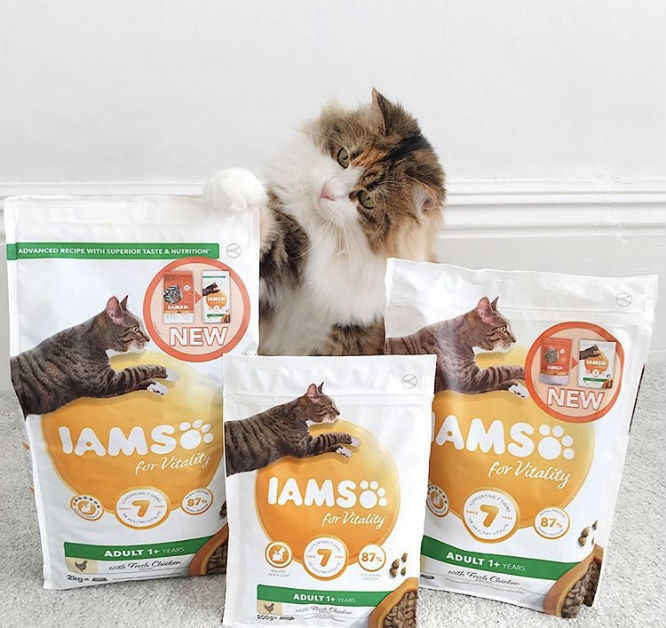
Does your dog constantly scavenge or your cat miaow at you for food, only to leave the bowl half empty? You’re not alone. In fact, many owners are concerned about their pet’s eating behaviours with a quarter of owners worrying their four-legged friend is left hungry after mealtimes while one in six question whether they are getting enough nutrients1. However, you may be surprised to hear that their unique eating habits are down to psychology not gastronomy.
While cats and dogs have been living with us for a long time, what remains in their DNA is the way they find and consume their food.
Dogs are natural scavengers…
Dog behaviourist Mandy Deveridge explains, “Dogs evolved to scavenge food to survive, so have an innate drive to search through what to us seems odd or even inappropriate – such as shopping bags or kitchen bins. Satisfying our dog’s inbuilt need to scavenge can contribute to a dog’s wellbeing.”
How can dog lovers accommodate this instinct to scavenge, while keeping their pets out of the rubbish? Mandy has some suggestions: “Feeding dogs using food puzzles is one way of captivating your four legged friend, or you could hide food around the house or garden.”
Tasty biscuits are ideal for food puzzles or playing lost and found. You can also make food puzzles at home, for example by taking a cardboard inner tube from a roll of toilet paper, placing some food inside, then folding over the ends and cutting a small hole in the middle. When your dog rolls it around the floor, the food falls out for them to snaffle up.
Another idea is to play a game where food is the reward – such as throwing and retrieving a ball.
“Teaching food games keeps your dog stimulated, active and happy,” says Mandy.
Cats are hunters…

When it comes to cats, there is often a mismatch between what we as humans believe cats want and what they actually need which is probably why almost half of owners (46%) feed their feline the amount of food they believe they want versus the recommended portion[1].
Cat behaviourist Naomi Opalinski explains, “The secret to a happy cat is understanding their wild origins. Cats are hunters – it is innate to them. They are also very inquisitive. In the wild, and in our gardens, cats are solitary hunters. In a natural setting, a cat will eat ten or more small meals a day, usually hunting from dawn to dusk.”
Some cats will happily adapt to twice-a-day feeding, but for those that won’t there a few simple changes that cat owners can make. In fact, all cats will appreciate a little more variety to their routine.
Firstly, it is a good idea to feed little and often as many like to graze and lots of food left out for long periods of time becomes less appetising for them. Even better, hide food in small quantities around the house, for them to sniff out.
Also, you could think about incorporating some food puzzles into your feeding routine, to mimic the natural foraging and hunting behaviour of your cat.
“Make meal times fun and take away the food bowl! Try using egg boxes, or paper bags with the handles cut off,” says Naomi. “You could also try scattering feed in different locations – for example on the stairs, or on different levels of a cat tree – or throw individual pieces of kibble for your cat to chase and eat,” adds Naomi.
The key to healthy vitality is a balanced diet…
Whichever way you choose to feed your pet, the most important thing is to ensure they receive complete and balanced nutrition which feeds their vitality.
Kellie Ceccarelli, IAMS Veterinary Manager adds, “IAMS for Vitality has been developed with high quality animal protein3 and is tailored to fit all life stages and specific needs allowing you to enjoy your pet at their very best. With fresh chicken and a new wheat-free[2] recipe, IAMS for Vitality combines high-quality animal protein[3] in crunchy kibbles with a vacuum coating to lock in irresistible flavours. Not only that but the crunchy kibbles with special tooth minerals help prevent tartar build up on teeth.
“The other important thing to remember is to check how much you should be feeding your pet to avoid over or under feeding. Always check the guidelines on the side of the pack to make sure you’re feeding the right amount for your pet’s age, weight and activity levels.”
For more information about the range and feeding guidelines, visit www.iams.co.uk/forvitality.
Sources
- [1] 3Gem Survey with 1,500 UK male and female pet owners
- [2] Produced in a factory that handles wheat
- [3] 85% for dogs/91% for cats out of total protein
- *Pricing at the discretion of the retailer
Tagged in Pets

